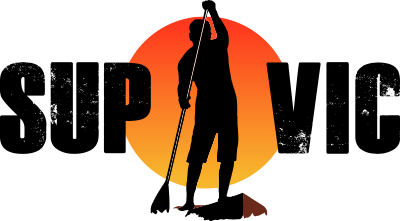SUP VIC – Introduction To Stand Up Paddle Boarding
SUP Vic would like to welcome you to the world of Stand Up Paddle Boarding!
These hints will help you progress on your SUP journey. SUP is easy to learn but may take some time to become fully refined. On a SUP board you can enjoy flatwater cruising, racing, surfing, yoga or downwinding… the choice is yours!
SUP is great fun, great for your fitness and can be enjoyed by the entire family.
SUP can be a wonderful experience, but if care is not taken then it has the potential to be dangerous. It is important that you always prioritise safety first! And never be worried about asking for advice; from your local retailer, from your fellow Pod crew, or any experienced stand up paddle boarder.
Your First Paddle
Your board
- Boards need to be in water deep enough that the fin does not catch in the sand
- Have a leg rope, this is your primary safety equipment).
- Find your board’s ‘sweet spot’. This is the best spot for you to stand on your board for maximum paddle efficiency. Every board is slightly different so don’t be scared to ask for help. Generally you are looking to keep the board fairly flat in the water, particularly at the tail and a good starting point is to position yourself directly over the centre handle.
Check your paddle
- is facing the right way – the curve of the paddle blade should be facing forward (bending away from you) as it enters the water.
Plan your paddle location, route and take a buddy
- Always plan your paddle so you are paddling into the wind to begin with and then the wind will assist your return paddle back to where you began.
- As you get started, where possible, go paddling with a friend or a group; this will help maximise your enjoyment whilst adding a safety factor and the opportunity to learn from experienced paddlers while you paddle. Don’t be backward in asking questions!
- For your first few paddles be mindful of your surroundings, ideally picking a location that has some flatwater – ie wind protected bays such as Half Moon Bay or Sandringham, Patterson Lakes or the marina at Martha Cove (depending of course on the wind direction). These locations may have boats so you will need to be aware of where you are on the water relative to other watercraft. Remember: Stay to the Right of oncoming craft on the water (the opposite to our road rules).
- On your first few paddles keep an eye on the distance you are out from the shore. Sometimes the wind will become stronger and start to push you further out than intended/anticipated. Note: If you’re over 400 meters offshore you are required to wear a Level 1 PFD within Victoria. Source one from your SUP retailer or paddle supplier. PFDs designed specifically for paddling are by far the best and most comfortable for SUPing.
- Be mindful of your fitness level. SUPing is a physical activity, so keeping an eye on your liquid and food intake, or you may find yourself fatiguing quickly.
- After your paddle, have dry clothing, food and drink ready. Even on a warm day you can get cool with some wind chill, especially if you’ve taken a fall into the water.
Wind
- On a SUP board the wind can be your best friend or can be potentially dangerous. There are many ‘weather apps’ available, allowing you to check the direction and strength of the wind.
- Whatever app you use, nothing will replace common sense. You may turn-up to your paddle location and the wind is blowing in the opposite direction. You need to be able change your plans accordingly. Be aware of your own limitations with the wind and never paddle in strong off-shore winds.
Paddle Stroke
- SUP is a great core workout. To achieve this, use your body as your main source of power and not your arms and shoulders.
- To get best results try to get your paddle out in front of you next to your board and then push your paddle straight down as your blade goes vertically into the water.
- 75% of your paddle power will happen in the first 35% of your stroke. Your abs and core muscles will last all day but paddling with your shoulders/arms is far less efficient. Try to exit the paddle from the water at your feet and where possible bring the paddle back just above the water in a straight line close to your board ready for your next stroke. You always want to get the best results with the least amount of energy expended.
- There are plenty of You Tube videos available on SUP paddling technique. Invest some time and watch some of them – particularly more recently produced ones which have the most up-to-date skill instruction/information.
Board Care
- Sun, sand and salt are three of the corrosive elements out there. Always wash your gear with fresh water and store your board properly after a paddle and your investment will last a lot longer! This includes paying particular attention to your leg rope and board attachment loop. Ensure they are well washed and inspected after each paddle, examining them for signs of fraying, cuts, damage, etc.
- Even with the best care, well-used leg ropes and attachment loops need to be turned-over and replaced every couple of years.
Happy and safe paddling and we’ll see you on the water!
SUP VIC Inc
